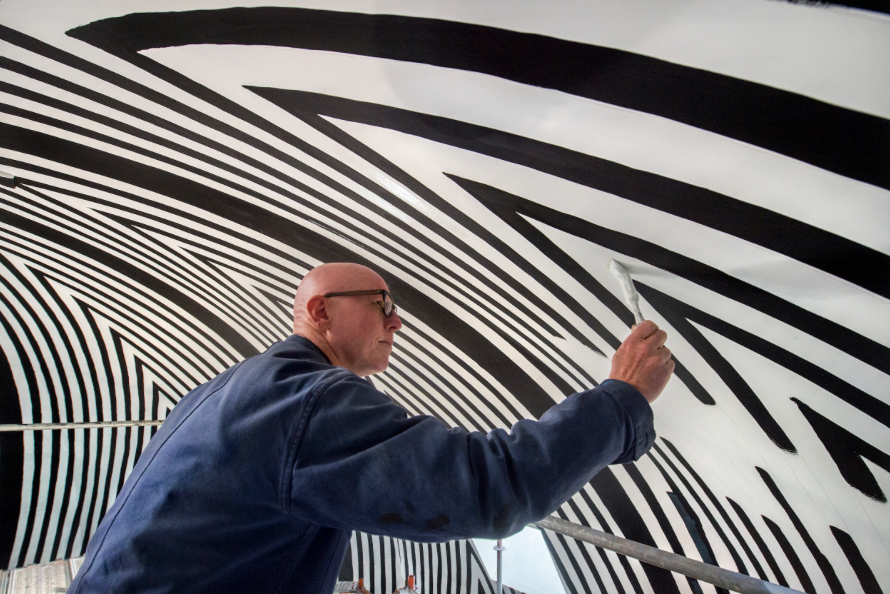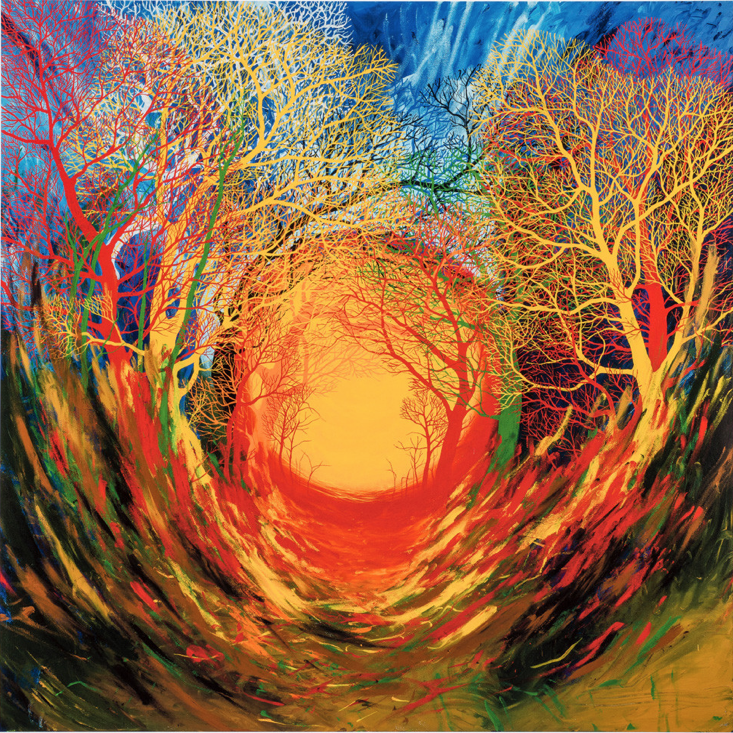- Home |
- Search Results |
- Robert Macfarlane on creating the cover of Underland with artist Stanley Donwood
Robert Macfarlane on creating the cover of Underland with artist Stanley Donwood
Robert Macfarlane’s new book Underland explores the lost worlds that lie beneath our feet. Here, he explains why ‘Nether’, a painting by long-time collaborator and Radiohead artist Stanley Donwood, is the perfect image for the book’s cover, both artistically and symbolically.


It would take me another five years to write Underland, which in that time has become the longest, strangest, deepest, darkest book I’ve ever written – and probably ever will write.
Except that while ‘Nether’ looks like a vast sun rising at the end of a sunken lane, it’s not. I remember asking Stanley about the image when we were together one day on Orford Ness, the shingle spit off the Suffolk coast where nuclear weapons were tested in the decades after the Second World War. “‘Nether’”, Stanley said then, “isn’t the sun. It’s the last thing you’d ever see. It’s the light of a nuclear blast that has just detonated. When you look at ‘Nether’, you’ve got about 0.001 of a second of life remaining, before the flesh is melted from your bones.” Oh.
Lustrous and lethal, fatal and beautiful, the image beckons the viewer’s eye on and down into the underworld. As such, it could hardly be truer to the preoccupations of Underland. For the underland is where we have long placed both what we fear and wish to dispose of, and what we love and wish to preserve.
Underland begins in a Dark Matter research laboratory a mile underground, designed to see back to the origins of the universe. It ends in a Deep Geological Repository beneath a frozen northern coast, designed safely to store nuclear waste for half a million years to come. And between those two distant sunken points Underland moves forwards in time, traversing human history from the beginnings of the Mesolithic to the Anthropocene-to-be, crossing subterranean cults and cultures from Mithraism to urban exploration, shamanism to cave-diving, as well as exploring the more-than-human underlands with which we are entangled, from burning oil and melting ice, to the underground fungal networks that conjoin single trees into communicating forests.
The first book I ever wrote, Mountains of the Mind (2003), was about the powerful fascination that mountains exert on the human spirit. I began on the summits of the world’s highest peaks; now, fifteen years on, in Underland I’ve completed a journey downwards to the darkness at the core of our earth and our imaginations. I wanted to write both an ancient and an urgent book, for it seems to me that the stories we tell ourselves now about the underland will be vital to shaping the future of the earth on which we exist. All of our lives are shaped by the underland – yet so few of us choose to look below the surfaces either of our landscapes or of our minds.

I wanted to write both an ancient and an urgent book, for it seems to me that the stories we tell ourselves now about the underland will be vital to shaping the future of the earth on which we exist.
Stanley and I have been friends and collaborators for nearly a decade now. He has now done the cover art for six of my books, and we have worked together on two books, one called Holloway (2013) and one called Ness, to be published soon. I knew Stanley’s work before I knew him, of course, because he is the mysterious cult figure behind all of Radiohead’s art since the band first formed (those snowy cyberscapes of Kid A, the screaming head of The Bends, the writhing forest creatures of King of Limbs). Many people around the world wear tattoos of Stanley’s art, some of them in unmentionable places.
Stanley’s range as an artist is extraordinary. For the covers of The Old Ways and Landmarks, he worked in linocut, using what he calls his ‘special little chisel’ to eke out striking and detailed images. The cover of Landmarks includes a snowdrop: ‘That’s the first flower I’ve ever drawn, printed or painted’, Stan said when he showed that cover, somewhat ruefully. The images for Ness and Holloway are done in pen and ink, and show an exceptional fineness of cross-hatching and interweaving lines. ‘Nether’ is acrylic on canvas: the unnaturally lustrous colours of a landscape on fire.

One last thing I should probably say about Stanley Donwood is that Stanley Donwood isn’t his real name. Or rather, it’s one of his real names. He has quite a few – among them Zachariah Wildwood, Michael Mortgage, and the name on his birth certificate (which he doesn’t tend to disclose) and probably several others that I’ve never heard him use. Anyway, I’ve always called him Stan and that’s that. He’s a genius, and I’m lucky to know and work with him."